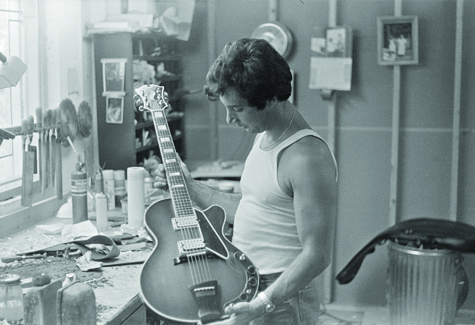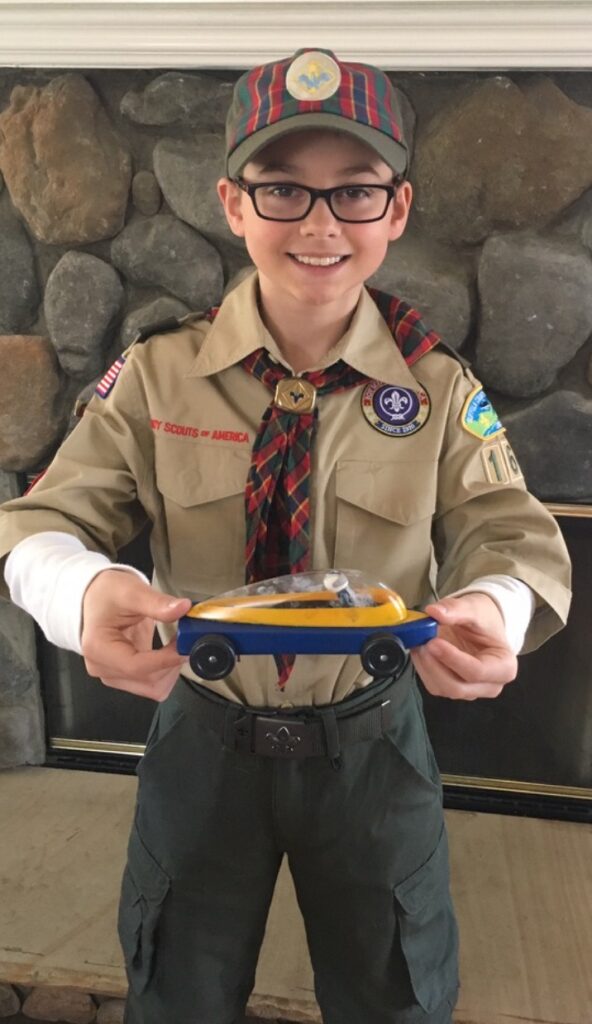North Fork guitar maker is recognized at Metropolitan Museum

In a small garage on Manhanset Avenue in Greenport, a music legend quietly spent the last two decades of his life making guitars that have been played by some of the best musicians in the world.
The faces of Archtop guitar aficionados light up at the mention of Jimmy D’Aquisto’s name, but one needn’t be a musician to value the beauty and craftsmanship of one of Mr. D’Aquisto’s guitars, hand-built in a tradition passed down by immigrant instrument makers who settled in Little Italy, where he learned his craft.
Mr. D’Aquisto is now the subject of an exhibit at New York’s Metropolitan Museum of Art, along with his mentor, John D’Angelico, and John Monteleone, an Islip luthier (someone who makes or repairs string instruments) who carries on the tradition.
Since the show opened, Greenport has been abuzz with talk of the unassuming man locals knew just as “Jimmy,” who lived in town from the mid-1970s until his death in 1995 at age 59.
Greenport Mayor David Nyce, a skilled furniture maker and a guitarist, found out about the show several weeks ago from a friend and fellow admirer of craftsmanship. He quickly jumped at the chance to check it out.
“I think it’s brilliant that a craftsman like that was here. We need to commemorate that sort of thing,” said Mr. Nyce. He plans to approach Southold Town about placing a memorial plaque at Mr. D’Aquisto’s former workshop, which is outside the village boundary.
Mr. Nyce said the exhibit, which includes a large number of guitars that Mr. D’Aquisto made in Greenport, also includes a video of him at work in his shop on Manhanset Avenue.
“The coolest part was that that was the time period when there was a resurgence of guitar making,” he said. “There was a collector who went around to makers asking for guitars, and there was a resurgence in boutique guitar makers.”
The instruments on display “look gorgeous,” he said.
Mr. Nyce said he once had a chance to play a D’Aquisto guitar, a nerve-wracking experience since the instruments sell for tens to hundreds of thousands of dollars.
“I used to take an annual pilgrimage to Mandolin Brothers on Staten Island. I’d been there often enough that the guys that own the place trusted me enough to take me to a room upstairs where they kept guitars that would sell for thousands and thousands of dollars,” Mr. Nyce said. “I was strumming away and I said, ‘It’s gorgeous,’ and they said, ‘It’s $10,000.’ I put it right down.”
Peter Stevens, who owns The Book Scout in Greenport, remembers visiting Mr. D’Aquisto several times in his studio, a small garage next to his house.
“He was a small, unassuming person to be the foremost maker in the world of carve-topped guitars,” he said. “I’d always been interested in guitars, and a friend of mine did some carpentry for him in exchange for a half-sized guitar, so I got a chance to watch him work.
“He used the best wood available in the world, whether European spruce or maple, he got it,” said Mr. Stevens. “He was always being interrupted on the phone when he was at work. Other luthiers would call him and explain their problem, hoping he’d help them, and he did.
“Sometimes he would make four or five guitars at once. I was a little intimidated about touching them, and figured I’d rather not,” he said. “He could play. I heard him play in the band at a wedding once, but he was primarily a luthier.”
[nggallery id=83 template=galleryview]
Musician Stan Wright, who teaches bass, guitar and drums at the East End Arts Council in Riverhead, remembers appearing on a public access television show with Mr. D’Aquisto not long before he died.
“I have a guitar that he designed. I spoke to him about the guitar and he said ‘I didn’t make the guitar,’ ” said Mr. Wright. “There was a company called Hagstrom. He collaborated with them. He would send the blueprints to them in Australia and then they would have someone in Hawaii build the guitar. They would send the neck to him and he would stamp his name on the guitar.”
Hagstrom wasn’t the only company for which Mr. D’Aquisto designed guitars, according to Jayson Dobney, curator of the exhibit at the Metropolitan Museum of Art.
“He had worked with Fender, which had a D’Aquisto line,” said Mr. Dobney. The luthier was consulting with another guitar manufacturer in California when he died in his hotel room after an epileptic seizure.
“He told me that every night around 5:30 or 6 o’clock, he would have a seizure, and the medicine made him feel so bad that he would rather have the seizure,” said Mr. Stevens.
Epilepsy may have also played a role in some of the later guitars Mr. D’Aquisto designed, said Mr. Dobney, pointing out that the luthier’s later designs were more minimalist and relied on unique styling, not elaborate inlays like the work that he did when he began apprenticing with John D’Angelico in Little Italy in the early 1950s.
Mr. D’Angelico had learned the trade from his uncle, Raphael Ciani, an Italian immigrant who was skilled in making mandolins and violins. But as those instruments waned in popularity, electrified archtop guitars, whose design incorporated the “F” shaped holes found on violins, became the rage among jazz musicians in the 1930s.
It was this style of guitar, which relied on the resonance of its hollow body but could be electrified for playing before large crowds, for which Mr. D’Angelico would become known.
“The advent of jazz was driving his decision to pursue these instruments,” said Mr. Dobney.
Mr. D’Aquisto, who was a young man living in Brooklyn in the early 1950s, first went into Mr. D’Angelico’s shop looking to buy a guitar. He was instantly enamored with the business, and said that he wanted to work there.
“He talked about how it was the coolest place ever, but D’Angelico said, ‘No you can’t, kid,’ ” said Mr. Dobney. Undaunted, Mr. D’Aquisto kept returning to the shop to try to lend a hand and, Mr. Dobney said, “One day, D’Angelico says, ‘Kid, you need a job?’ There was a gradual building of trust over years, learning every aspect of the trade. The guitars made in the early 1960s are some of the most gorgeous instruments you’ll ever see, with perfect cutaways and all of this sort of more ornamental work. The bindings and inlays were done by D’Aquisto at that time. You can see the young aspiring artist putting everything into this to get the master to appreciate the work.”
Mr. Dobney said the museum has spent the past three and a half years finding instruments for the exhibit and getting permission from musicians, including Paul Simon and Steve Miller, to put them on display.
“Early on you’d start to see elements of him doing wood bridges and pickguards, but by the late ’80s, his last models — The Avant Garde, Advance and Centura — these models are very distinct. They’re sometimes called the modern series,” Mr. Dobney said.
“He was really an innovator. D’Angelico made Art Deco classic instruments, but this was a whole new direction for D’Aquisto,” he said. The modern guitars don’t use F holes, but instead have oval or teardrop-shaped sound holes, all of which produce a unique and distinctive sound. Mr. D’Aquisto also made several solid body electric guitars, most of them for Steve Miller, while he was working in Greenport. His last guitar, the Advance, had removable baffles that could be put in the sound holes to change the sound, but he had time to make only one of them before he died. It is on display in the show.
Even if Mr. D’Aquisto had been able to produce more than one of those guitars, Mr. Dobney said, it’s unlikely that many people would have been able to play them.
“He wasn’t advertising,” he said. “If you were a guitar player in the right circles, you got yourself on a waiting list that was years long.”
The exhibit continues through July 4.
Guitar Heroes
On view through July 4 at Metropolitan Museum of Art, 1000 Fifth Ave.,
New York, 212-535-7710.









